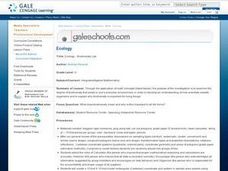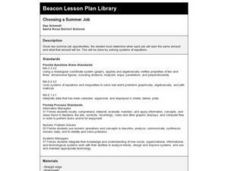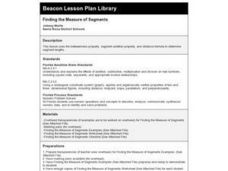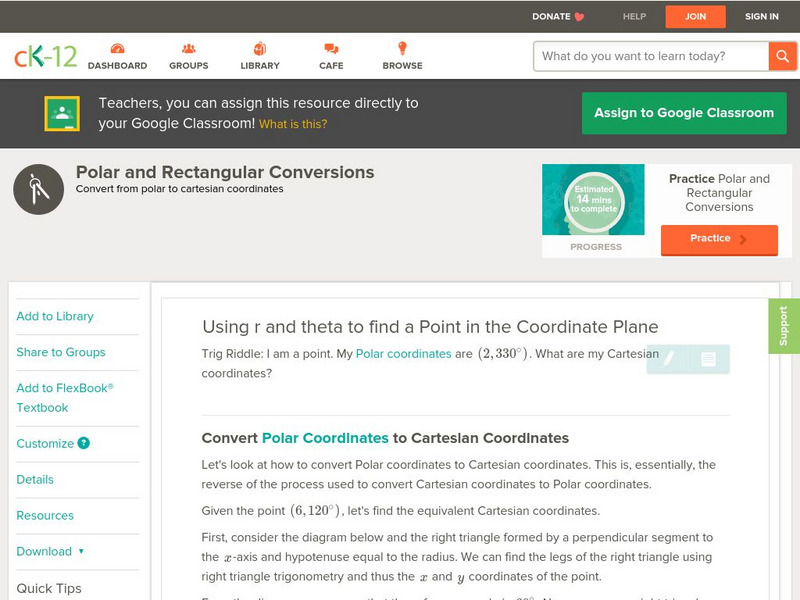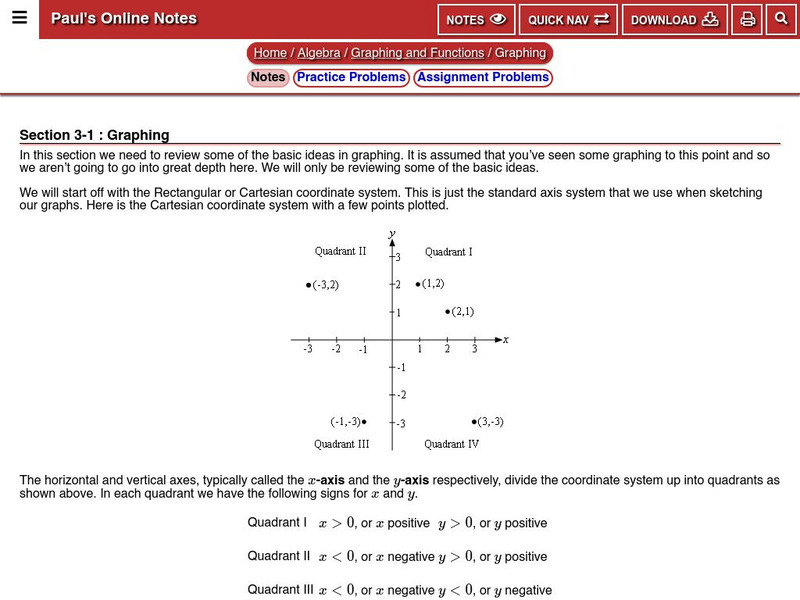Curated OER
Inquiry Unit: Modeling Maximums and Minimums
Young mathematicians explore the maximun area for patio with the added complexity of finding the mimimum cost for construction. First, they maximize the area of a yard given a limited amount of fence and plot width v. area on a...
Curated OER
Trig Review
Twelfth graders review the 6 identities of trigonometry. In this trig lesson, 12th graders review the importance of the right triangle as it relates to sine, cosine and tangent. They review the basic trig identities and how it relates to...
Curated OER
Relating Algebra to Geometry
Learners investigate the connection that exists between Algebra and Geometry. They classify two and three-dimensional figures. Pupils use formulas to solve problems in geometry and use appropriate measuring devices in the right contexts.
Curated OER
Ecology - Biodiversity Lab
Studnents examine the degree of biodiversity that exists in one's everyday environment, in order to develop an understanding of how scientists classify organisms and to explain why biodiversity is important for living things.
Curated OER
Interpreting Graphs
Students investigate graphs. In this graphing lesson, students create a graph regarding the population of California. Students extrapolate answers concerning the data set.
Curated OER
A Perpendicular Pilgrimage
Ninth graders design a safe passage through a 2-D obstacle. In this geometric math lesson, 9th graders engage in a hands on activity to better understand the concept of geometric and algebraic perpendicularity. Students will work in...
Curated OER
Slope Right Up
Learners use triangles to find the length and slope of each side. After connecting the vertices, they add points based on their specific instructions. They use the Pythagorean Theorem to complete a worksheet to end the lesson.
Curated OER
Conic Sections and Locii
Students differentiate between ellipse and hyperbola. In this algebra lesson, students graph and solve elliptical equations. They use the cabri program to create the different conics and move them around.
Curated OER
Where In the World Are We?
Fifth graders read postcards and find their locations on maps. They use the pictures and text on the postcards to write about imaginary vacations. They compute the mileage and compare it to TripMaker data.
Curated OER
Choosing a Summer Job
What did you do over your summer vacation. Young wage earners must compare summer job options, and determine when each job earn the same amount and what that amount be. This be done by creating, graphing, and solving systems of...
Curated OER
Finding the Measure of Segments
Young scholars observe and solve examples of betweenness, ruler postulate, and segment addition postulate. They complete the Finding the Measure of Segments worksheet using the distance formula.
Curated OER
Sloping and Intersecting a Linear Function
High schoolers examine and discuss typical linear equations, and the difference between a linear and nonlinear equation. They observe examples of linear equations and complete a worksheet.
Curated OER
Gridding a Site
Students establish a grid system over an archaelogical site. They label each grid unit. They determine the location of artifacts within each grid unit. They construct a scientific inquiry concerning the location of artifacts on the site.
Cool Math
Coolmath: Intro to Graphing the Cartesian (Rectangular) Coordinate System
A quick tutorial on the basics of the Cartesian (rectangular) coordinate system.
Texas A&M University
Wtamu Virtual Math Lab: Beginning Algebra: The Rectangular Coordinate System
Find step-by-step examples to help learn four objectives based on ordered pairs in a Cartesian coordinate system.
Johan Claeys
Math Abundance: From a Cartesian Equation to a Polar Equa
Shows how to convert a cartesian equation (rectangular coordinates) to a polar equation.
Lawrence Hall of Science
The Math Page: Skill in Algebra: Rectangular Coordinates
Here is a site that clearly and thoroughly explains the Cartesian coordinate system. There are example problems solved, problems for the student to attempt, and answers to the student problems. Point this site out to students who have...
Interactive Mathematics
Interactive Mathematics: Rectangular Coordinates
Descriptions of x- and y-coordinates are presented, followed by an interactive game that demonstrates how to plot points on the coordinate plane. Examples and exercises are provided for practice.
CK-12 Foundation
Ck 12: Trigonometry: Polar to Rectangular Conversions
[Free Registration/Login may be required to access all resource tools.] This lesson teaches you how to change Polar coordinates into rectangular coordinates.
Help Algebra
Help algebra.com: Rectangular Coordinates
The parts of the coordinate plane are described and plotting ordered pairs is demonstrated with several examples. The four quadrants of the coordinate plane are also defined.
Tech Target
Whatis.com: Cartesian Coordinates
This site from Whatis.com provides a great definition of cartesian coordinates. The definition is medium-sized in length and has links to additional information as well.
CK-12 Foundation
Ck 12: Trigonometry: Rectangular to Polar Conversions
[Free Registration/Login may be required to access all resource tools.] Convert rectangular coordinates to polar coordinates.
Varsity Tutors
Varsity Tutors: Hotmath: Practice Problems: Polar Coordinates
Hotmath provides 20 practice problems relating to polar coordinates and complex numbers. Each of the practice problems include a step-by-step guide for solving.
Paul Dawkins
Paul's Online Notes: Algebra: Graphing
Detailed math tutorial features notes and examples that take a look at the Cartesian (or Rectangular) coordinate system. Provides definitions of ordered pairs, coordinates, quadrants, and x and y-intercepts.



